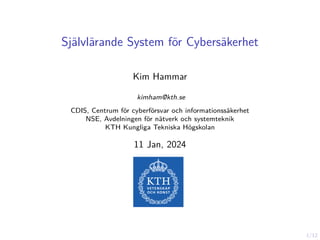
Självlärande System för Cybersäkerhet. KTH
- 1. 1/12 Självlärande System för Cybersäkerhet Kim Hammar kimham@kth.se CDIS, Centrum för cyberförsvar och informationssäkerhet NSE, Avdelningen för nätverk och systemteknik KTH Kungliga Tekniska Högskolan 11 Jan, 2024
- 2. 2/12 Hur kan vi mitigera cyberangrepp med AI?
- 3. 3/12 Hur kan vi mitigera cyberangrepp med AI?
- 4. 3/12 Motivation I Utmaningar: I Attackmetoder är i en konstant förändring och utveckling I Komplicerade IT-infrastrukturer I Forskningsmål: I Automatisera säkerhetsfunktioner I Anpassa system till föränderliga attackmetoder Attackerare Klienter . . . Försvarare 1 IDS 1 alarm Gateway 7 8 9 10 11 6 5 4 3 2 12 13 14 15 16 17 18 19 21 23 20 22 24 25 26 27 28 29 30 31
- 5. 4/12 Automatiserad Säkerhet: Nuvarande Forskningslandskap Nivåer av säkerhetsautomatisering Ingen automatisering. Manuell detektering. Manuell prevention. Inga alarm. Ingen automatiserad attack mitigering. Brist på verktyg. 80-talet 90-talet 00-talet-Nu Forskning Operatörassistans. Manuell detektering. Manuell prevention. Granskningsloggar. Säkerhetsverktyg. Partiell automatisering. System har automatiserade funktioner för detektering/ prevention men kräver manuell uppdatering och konfiguration. Intrångsdetekteringssystem. Intrångspreventeringssystem. Hög automatisering. Systemet uppdaterar sig självt automatiskt. Automatiserad attackdetektering. Automatiserad attackmitigering.
- 6. 5/12 Exempel: Intrångsmitigering I En försvarare opererar en infrastruktur I Består av komponenter sammankopplade i ett nät I Komponenterna exekverar nätverkstjänster I Försvararen övervakar nätet och kan utföra responsaktioner I En attackerare har som mål att göra ett intrång I Vill få tillgång till komponenter I Utför rekognisering samt exploatering av sårbarheter Attackerare Klienter . . . Försvarare 1 IDS 1 alarm Gateway 7 8 9 10 11 6 5 4 3 2 12 13 14 15 16 17 18 19 21 23 20 22 24 25 26 27 28 29 30 31
- 7. 6/12 Steg 1: Emulering Modell s1,1 s1,2 s1,3 . . . s1,4 s2,1 s2,2 s2,3 . . . s2,4 Virtuell miljö . . . Virtuellt datornät Virtuella enheter Emulerade Tjänster Emulerade aktörer IT Infrastruktur Konfiguration Mätvärden Verifierad säkerhetspolicy Optimerad säkerhetspolicy
- 8. 7/12 Steg 2: Samla in data 0 2000 4000 6000 8000 probability cve-2010-0426 0 2000 4000 6000 8000 cve-2015-3306 0 2000 4000 6000 8000 cve-2015-5602 0 2000 4000 6000 8000 cve-2016-10033 0 2000 4000 6000 8000 cwe-89 0 2000 4000 6000 8000 O probability cve-2017-7494 0 2000 4000 6000 8000 O cve-2014-6271 0 5000 10000 15000 20000 O ftp brute force 0 5000 10000 15000 20000 O ssh brute force 0 5000 10000 15000 20000 O telnet brute force intrusion no intrusion intrusion model normal operation model Fördelningar av intrångsdetekteringsalarm under olika typer av intrång. I Första steget i vår metod är att samla in stora mängder data från IT infrastrukturen. I Vi samlar in data både under normaltillstånd samt under olika typer av intrång (emulerade intrång).
- 9. 8/12 Steg 3: Modellering I Vi modellerar systemet med hjälp av de mätvärden vi samlat in. I Statistiska modeller baserat på I Hotmodellering I Reglerteknik I Beslutsteori I Spelteori I Exempel på frågor vi kan svara med hjälp av modellen: I Vad är sannolikheten att ett intrång pågår? I Vilken effekt fås om vi uppdaterar vår säkerhetspolicy? s1 s2 s3 s4 s5 s4 . . . . . . . . .
- 10. 9/12 Steg 4: Optimering H C ∅ Optimering Modell Simulering Teoretiskt optimal säkerhetspolicy I Baserat på modellen och simuleringar så optimerar vi säkerhetspolicyn för systemet. Tekniker för optimering: I Artificiell intelligens I Förstärkningsinlärning I Dynamisk programmering I osv.
- 11. 10/12 Steg 5: Implementering Attackerare Klienter . . . Automatiserad säkerhetsstrategi 1 IDS 1 alarm Gateway 7 8 9 10 11 6 5 4 3 2 12 13 14 15 16 17 18 19 21 23 20 22 24 25 26 27 28 29 30 31
- 12. 11/12 Vår metod för att automatiskt beräkna säkerhetsstrategier s1,1 s1,2 s1,3 . . . s1,n s2,1 s2,2 s2,3 . . . s2,n . . . . . . . . . . . . . . . Emuleringssystem IT infrastruktur Modellskattning & Systemidentifiering Mappning av säkerhetsstrategi π Selektiv replikering Implementation av säkerhetsstrategi π Simuleringssystem Förstärkningsinlärning & optimering Utvärdering & skattning av modeller Automatiserad säkerhet & självlärande system
- 13. 12/12 Referenser I Referenser till artiklar och videos finns tillgängligt på: https://www.kth.se/cdis
